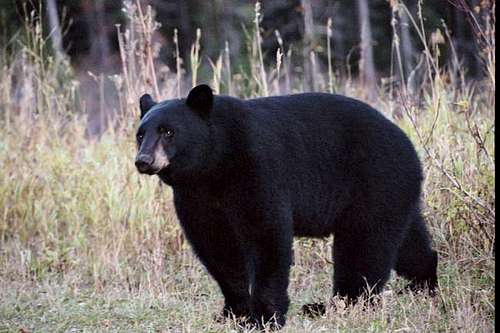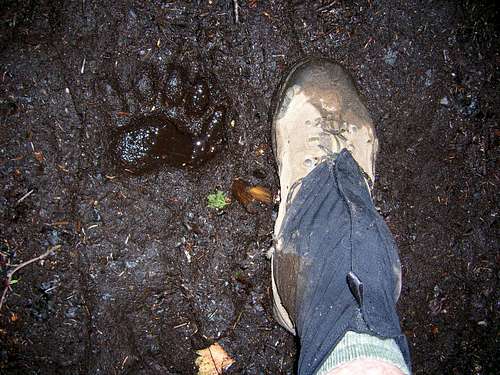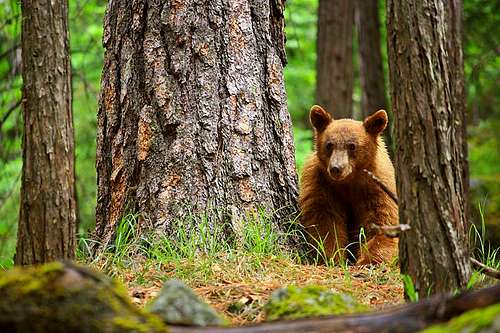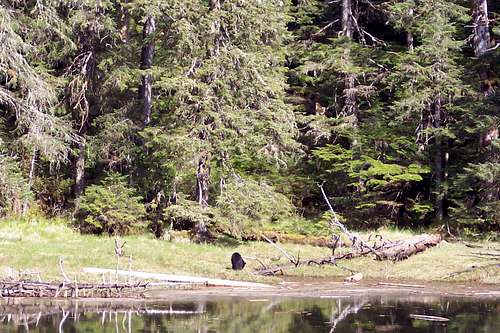Layout designed for best viewing on a "1024 x 768" screen.
Black Bears
![A Cinnamon Phase Black Bear, seanpeckham photo.]() |
![A Black Phase Black Bear, kyledod photo.]()
|
|---|
Introduction:
The Rocky Mountains are home to the Black Bear. This opportunist is amazingly adaptable and can be seen in many different habitats, from the valleys to the upper reaches of the timber. The public perception of the Black Bear is one of Smokey the Bear from the National Forest Service encouraging us to “Stomp Out Forest Fires.” The Black Bear appears to be cute and cuddly and is portrayed as unintelligent. This could not be any further from the truth. The Black Bear is a highly developed master of his domain who knows how to survive in all seasons and will be able to adapt to seasons of plenty and seasons of little food.
In the fall, Black Bears can frequently be seen as they are focused on storing up food for their upcoming hibernation. Look for Black Bears as they feed on open hillsides near the edges of timber and along creek bottoms where they might be feeding on berries.
Please attach your Quality Black Bear photos.Black Bear, Ursus americanus
![Adirondack Bear]() A Black Bear Track, rasgoat photo.
A Black Bear Track, rasgoat photo.
As the smallest bear in North America the Black Bear is an adaptive opportunistic feeder that has a range throughout North America. Interestingly enough not all Black Bears are black. Black bears come in color phases including: black, brown, cinnamon, blonde and even a white-bluish color known as a glacier bear.
Distinguishing between a Black Bear and Grizzly is relatively easy when the following guidelines are considered. For more information go to the Montana Department of Fish, Wildlife and Parks
Bear Identification page.
1) Black Bears have a straight facial profile as compared to a dish-shaped face on a Grizzly.
2) Grizzlies have a pronounced hump on their shoulders, Black Bears do not.
3) Black Bear claws are sharply curved and seldom over 1½ inches in length compared to a longer (2-4 inches) and less curved claw of a Grizzly.
4) Black Bear ears are longer and pointy, Grizzly ears appear to be short and rounded.
5) Lastly a Grizzly rear molar is never less than 1 ¼ inches in length whereas a Black Bear rear molar is never more than 1 ¼ inches in length.
A typical male Black Bear, called a boar, will measure about 3 feet high at the shoulders, be about 6 feet in length and could weigh up to 400 pounds. Females, called sows, are smaller. Black Bears live up to 25 years in the wild but a normal lifespan is about 10 years of age.
Black Bears have an outstanding sense of smell; their hearing and vision is not outstanding.
Black bears are extremely adaptable and show a great variation in habitat types. They will eat pretty much anything that they find in their habitat. In the spring their diet is rich in new vegetation which helps get their digestive system going again after a lengthy hiatus due to hibernation. Bear will also feed on winter-killed animals. In the summer berries are another crucial food source. Insect larva, such as ants, hornets, wasps and bees, are also a source of protein for the Black Bear.
Black bears are loners except in the case of a sow with cubs.
Black Bears do not actually hibernate all winter. They have times when they stir for brief moments. Studies indicate that during the winter their body temperatures drop as does the metabolic rate. They also do not eat, drink, urinate or defecate.
Life Cycle:
![Bear Cubs]() Black Bear twins, brianhughes photo.
Black Bear twins, brianhughes photo.![Yosemite black bear]() A "Cinnamon Phase" Black Bear Cub, Misha photo.
A "Cinnamon Phase" Black Bear Cub, Misha photo.
Black Bears reach sexual maturity between 3 to 6 years of age depending upon habitat and other environmental factors. The breeding season for Black Bears occurs in June and July. The young are born in January or February after a 7 month gestation. They are born blind, almost hairless, and weigh less than 1 pound. The sow has rich milk that help the cubs grow rapidly.
By May, the cubs will weigh about 5 pounds and will have grown a nice coat of soft fur. They will remain under their mother’s care and tutelage until they are 1 ½ to 2 ½ years old.
The cubs are totally dependent on their mother for protection and education about their environment. Cubs quickly climb trees when their mother warns them of danger.
Distribution:
![Black Bear Feeding At Waters Edge]() Black Bear feeding by small pond in the spring, FlatheadNative photo.
Black Bear feeding by small pond in the spring, FlatheadNative photo.
There are at least 600,000 Black Bears in North America. The Black Bear can be located in 41 of 50 other states in the United States. It is also widely distributed in Canada. There are a few scattered populations in Mexico as well.
Black Bears live in many different habitats. I have seen them on the ocean as well as near the tree line in the Rocky Mountains.
The Black Bear as a Predator:
![Black Bear Scat]() Black Bear Scat
Black Bear Scat
Black Bears are omnivorous. They will kill small animals and any of the young ungulates, such as deer. They have also been credited with killing young elk and moose calves. The Black Bear boars are a threat to Black Bear cubs.
They normally kill by biting the neck and shoulders, though they may break
the neck or back of prey with blows from the paws.
In the spring, Black Bears occasionally prey on cattle, sheep, pigs and goats. This is usually a result of a poor supply of natural food sources. Livestock depredations by Black Bears occur mostly in spring.
They can also damage fruit trees and also wreck destruction on honey bee hives. They are incredibly intelligent and can avoid many traps that bee keepers set to foil the bear’s attempt to get the bee larva.
Black Bears seldom attack humans unless cornered, threatened, or wounded. In North American, 14 people have been killed by Black Bears since the year 2000, it is estimated that there have been only 56 documented killings of humans by black bears in North America in the past 100 years.
The Black Bear is an extremely powerful animal and is potentially dangerous to humans. If they are encountered with young or a source of food they can become aggressive and will defend their space. Use caution when you see a Black Bear. Sows with cubs must always be respected. A rule of thumb is never to come between or near a mother bear and her young.
Usually the bear will give a snort and leave the area, but sometimes they attack without provocation. Several people have been victims of these unprovoked attacks.
It is recommended to carry
Bear Deterrent Spray as a defense against Mountain Lion and Bear attacks.
Safety in Bear Country:
![Bear Closure Area]() Grizzly Area Closure Sign, saintgrizzly photo.
Grizzly Area Closure Sign, saintgrizzly photo. from The US National Forest Service
Stay informed about recent bear activity in the area.
• Leave a travel plan with a friend, and sign in and out at the trailhead so that someone will know when to expect your return.
• If camping use
Bear Proof Food Containers.
• Avoid sudden encounters and destruction of habitat. Stay on trails.
• Hike in groups to avoid surprising bears.
• Hike in daylight hours only.
• Make human sounds by talking, singing, or clapping your hands. Avoid high-pitched voices.
• Stay alert. Be aware of your surroundings. The potential for a bear encounter always exists. Look for paw prints, droppings, fresh diggings, torn-apart logs, and rocks that have been turned over. These may signal that a bear is active in the area.
• It is easy to become absorbed in photography, bird watching, or sightseeing. Stay alert.
• Bear food supplies such as berry fields, fish spawning areas, and animal carcasses should be recognized and avoided.
• Watch for noisy streams and wind directions that may mask your sound and scent.
• All bears have the ability to climb trees, some better than others.
• Just because you don't see a bear doesn’t mean they are not around. Grizzly bears hide or make daybeds in thick brush, often near trails.
• Always carry a used bandana, shirt, or parka that you can drop easily. Avoid dropping food, this will only encourage the bear's aggressiveness toward other hikers.
IF YOU ENCOUNTER A BEAR
• Carry
Bear Deterrent Spray and know how to use it.
• If you see a bear, stay calm and give it plenty of room. Do not startle it; detour slowly, keeping upwind so it will get your scent and know you are there. If you can't detour wait until it moves away from your route before proceeding.
• When a bear first detects you, it may stand upright and use all of its senses to determine what and where you are. Once it identifies you it may ignore you, move slowly away, run, or it may charge. A wild bear rarely attacks unless it feels threatened or provoked.
• On four legs, a bear may show agitation by swaying its head from side to side, making huffing noises and clacking its teeth.
• A charge or retreat may follow. Flattened ears and raised hair on the back of the neck indicate aggressive intent. If a bear runs with a stiff, bouncing gait, it may be a false charge.
• Never run, and do not try to climb a tree unless you are sure you have time to climb at least 10 feet before the bear reaches you. Bears can run very fast.
• If attacked by a bear, do not run. Bears can easily outrun you. Try playing dead. Lie flat on your stomach, or lie on your side with your legs drawn up to your chest. Clasp your hands over the back of your neck. Bears have passed by people in these positions without harming them.
Threats from Mankind:
![Black Bear]() Black Bear feeding on hillside
Black Bear feeding on hillside
The main threats to the Black Bear are habitat loss, destruction of range land, human encroachment, road-kills, poaching and depredation kills. Once again humans are encroaching on the Black Bear’s habitat by building homes in the prime areas where the bears live.
Selective harvesting is also seen as threat by some and others consider it necessary for managing the population.
Black bears often cause damage at homesteads, construction camps, or even in towns and are destroyed as nuisance animals. These depredation kills can be minimized or eliminated if garbage and other food items which attract bears to camps or residences are eliminated.
Conservation:
American black bears are listed as a threatened subspecies in Louisiana, eastern Texas. Although there were probably once as many as two million black bears in North America long before European colonization, the population declined to a low of 200,000 as a result of habitat destruction and unrestricted hunting. By current estimates, more than 800,000 are living today on the continent.
In four states Black Bears are state-listed as rare, threatened or endangered (Lousiana, Florida and within the historic range of black bears in southern Mississippi and eastern Texas). The Florida black bear subspecies is listed as threatened by the state of Florida. In most of the remaining states, black bears are classified as a game animal. In Canada the bears are classified as a pest species in the agricultural areas of Manitoba, while they are classified as a game animal and/or furbearer in the rest of Canada. In Mexico, the black bear is listed as Endangered by Mexican wildlife authorities.
The Future:
The future for Black Bears seems bright in the Rocky Mountains. Thus far the habitat has been preserved and the species is more than holding its own against other predators.
Black Bears in other parts of the county appear to not be fairing as well. Hopefully, current conservation efforts will prove effective and these at-risk populations will also be saved. We all can help by asking our local legislators to set aside funding to help secure habitat and work together at increasing secure zones where Black Bears can thrive.











Comments
Post a Comment